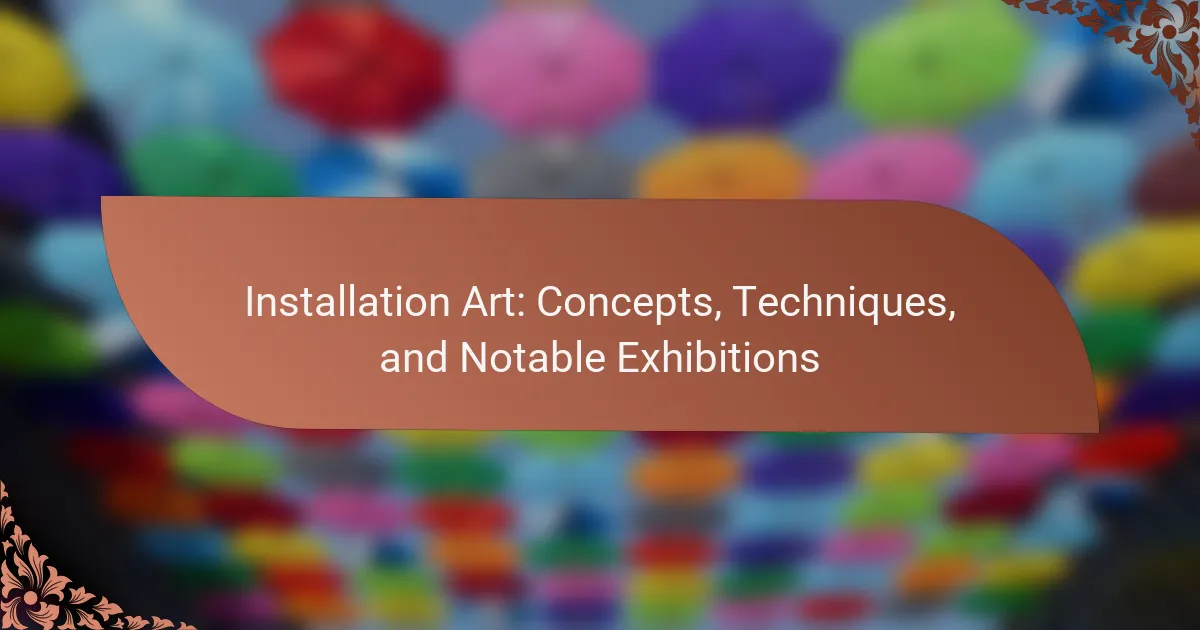Installation art invites viewers to engage physically and emotionally through immersive experiences. This article explores key characteristics like site-specificity and interactivity, common techniques used by artists, and notable exhibitions that exemplify these concepts. It also addresses the challenges artists face in creating impactful installations and highlights future trends shaping the medium.

What are the defining characteristics of installation art?
Installation art is characterized by its immersive and experiential nature. It often transforms a space, inviting viewers to engage with the artwork physically and emotionally. Key characteristics include site-specificity, interactivity, and the use of various materials and media.
Site-specificity means the artwork is created for a particular location, enhancing its meaning. Interactivity encourages audience participation, making the experience unique for each viewer. Diverse materials, such as light, sound, and everyday objects, contribute to the artwork’s complexity and depth.
Notable exhibitions, like Yayoi Kusama’s Infinity Mirror Rooms, exemplify these characteristics, offering a blend of visual stimulation and personal reflection. These elements make installation art a dynamic and evolving form of contemporary expression.
How does installation art differ from traditional art forms?
Installation art engages viewers in immersive experiences, contrasting with traditional art forms that often emphasize static viewing. Traditional art typically focuses on individual pieces displayed in galleries, while installation art transforms entire spaces, inviting interaction and exploration. Notable exhibitions, such as those by Yayoi Kusama and Olafur Eliasson, illustrate how installation art can evoke emotional responses and challenge perceptions of space. This unique attribute of interactivity distinguishes installation art from more conventional methods, making it a dynamic and evolving form of artistic expression.
What role does space play in installation art?
Space plays a crucial role in installation art, influencing the viewer’s experience and interaction. The spatial context can transform an ordinary environment into a compelling narrative, guiding perception and emotion. Artists often manipulate dimensions, light, and materials to create immersive experiences that engage audiences. Unique attributes of installation art include site-specificity, where the artwork is designed for a particular location, enhancing its impact. Through thoughtful spatial arrangement, installation art invites exploration and challenges traditional boundaries of art.
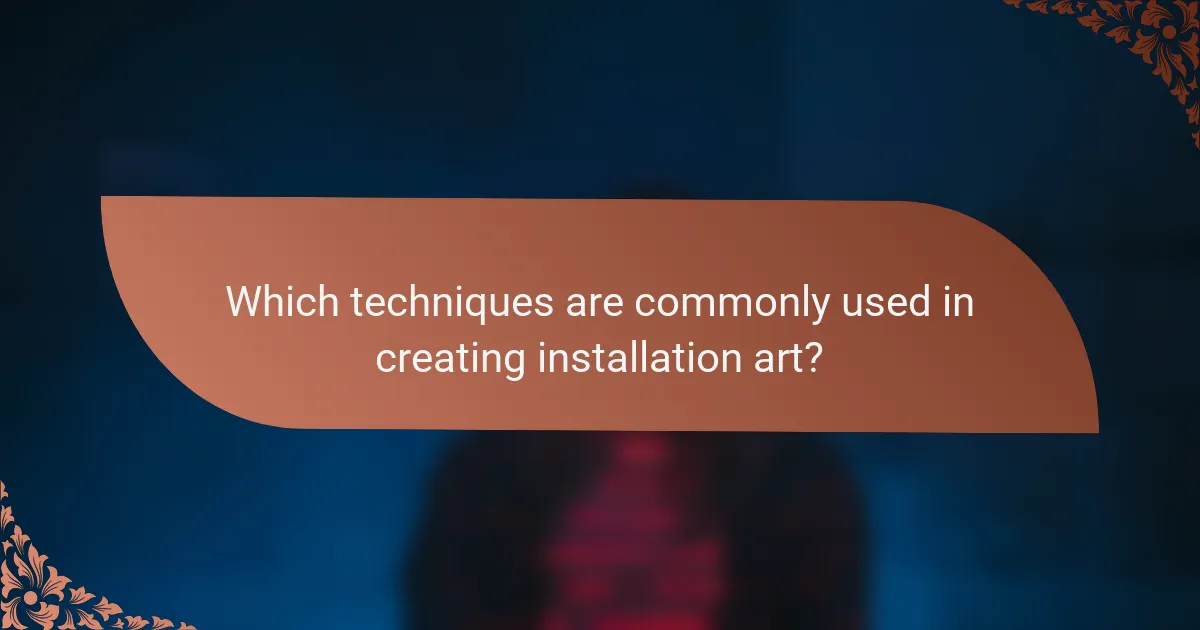
Which techniques are commonly used in creating installation art?
Common techniques in creating installation art include immersive environments, interactive elements, and the use of unconventional materials. Artists often utilize spatial arrangements to engage viewers and evoke emotions. Furthermore, multimedia components, such as sound and video, enhance the sensory experience, making the artwork more dynamic. Collaboration with architects and designers frequently occurs to create site-specific installations that resonate with their surroundings.
How do artists incorporate technology in installation art?
Artists incorporate technology in installation art by using interactive elements, digital media, and immersive environments. This integration enhances viewer engagement and transforms traditional art experiences. Notable examples include installations that utilize virtual reality, projection mapping, and soundscapes, creating dynamic narratives. Unique attributes of these works often include audience participation, where viewers influence the artwork’s outcome, fostering a deeper connection. Rarely, some installations employ artificial intelligence to adapt in real-time, showcasing technology’s evolving role in contemporary art.
What materials are frequently utilized in installation art?
Installation art frequently utilizes materials such as wood, metal, fabric, plastic, glass, and found objects. These materials contribute to the immersive experience and conceptual depth of the artwork. Unique attributes of installation art include the integration of light, sound, and interactive elements, enhancing viewer engagement. Rarely, artists may use unconventional materials like organic matter or digital technology to challenge perceptions and provoke thought.
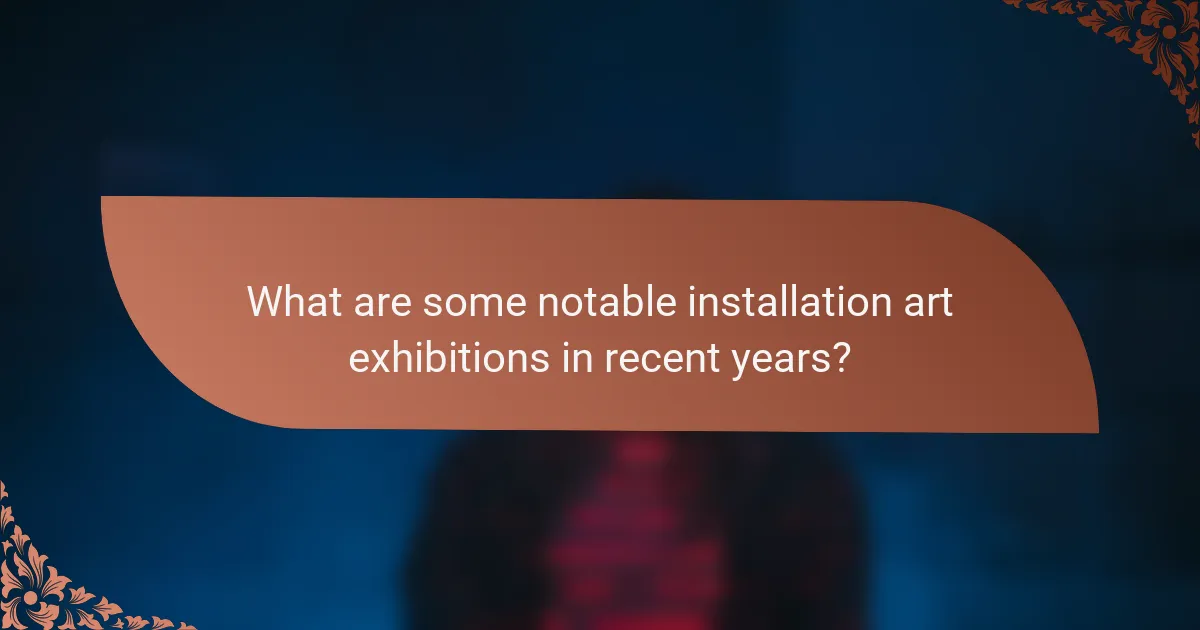
What are some notable installation art exhibitions in recent years?
Recent notable installation art exhibitions include “The Milk of Dreams” at the Venice Biennale 2022, which explored themes of transformation and identity. Another significant exhibition was “Kara Walker: Fons Americanus” at Tate Modern in London, highlighting race and history through a monumental fountain. “Yayoi Kusama: Infinity Mirror Rooms” at the Hirshhorn Museum showcased immersive environments reflecting Kusama’s unique artistic vision. Lastly, “The Weather Project” by Olafur Eliasson at Tate Modern captivated visitors with its atmospheric installation, emphasizing human connection to nature.
Which exhibitions have had a significant cultural impact?
Installation art exhibitions have significantly influenced cultural discourse and artistic practices. Notable examples include “The Weather Project” by Olafur Eliasson, which transformed the Tate Modern in 2003, engaging viewers in a collective experience of light and space. Another impactful exhibition is “The Obliteration Room” by Yayoi Kusama, which invited participation and dialogue around themes of infinity and community. Additionally, “The Dinner Party” by Judy Chicago remains a landmark work, addressing women’s history and gender equality through its intricate table settings. These exhibitions exemplify installation art’s capacity to provoke thought and inspire social change.
How have installation art exhibitions evolved in different regions?
Installation art exhibitions have evolved significantly across different regions, influenced by cultural, social, and technological factors. In Europe, installation art gained prominence in the late 20th century, often reflecting political themes and historical contexts. For instance, artists like Olafur Eliasson use immersive environments to engage viewers in discussions about climate change.
In North America, installation art has become a medium for exploring identity and community. Artists such as Kara Walker create thought-provoking installations that address race and history, often incorporating local narratives.
Asia has seen a rise in digital installations, blending technology with traditional art forms. Artists like teamLab in Japan utilize interactive digital elements to create immersive experiences that challenge perceptions of space.
Latin America has embraced installation art as a form of social commentary, with artists like Doris Salcedo addressing issues of violence and displacement. These exhibitions often incorporate local materials and community participation, emphasizing cultural identity.
Overall, installation art exhibitions reflect regional characteristics and societal issues, showcasing a diverse range of artistic expressions worldwide.
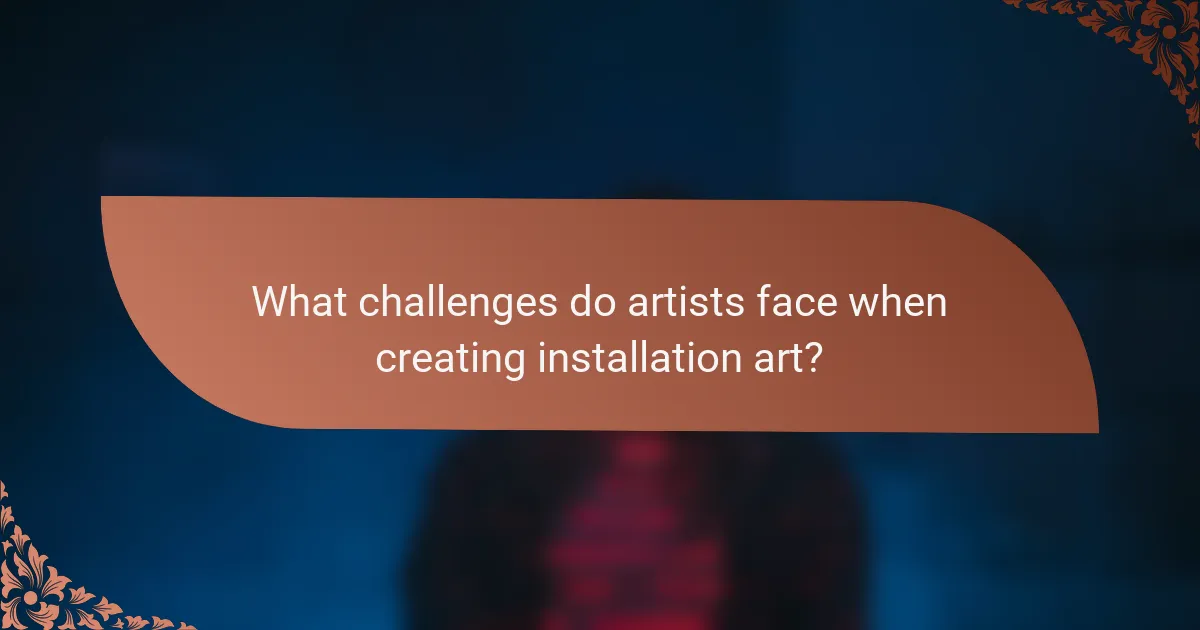
What challenges do artists face when creating installation art?
Artists face numerous challenges when creating installation art, including conceptualization, space constraints, and audience engagement. The need for innovative ideas can lead to creative blocks. Additionally, logistical issues like sourcing materials and technical limitations can hinder execution. Lastly, ensuring the installation resonates with viewers while conveying the intended message adds another layer of complexity.
How do logistical issues affect installation art projects?
Logistical issues significantly hinder installation art projects by affecting planning, execution, and overall impact. Factors like space availability, transportation, and installation time can limit artistic expression. For example, limited access to venues may force artists to compromise on scale or materials. Additionally, unexpected delays can disrupt the timeline, impacting audience engagement. Effective logistical management is crucial for the success of installation art, ensuring that the artist’s vision is realized without compromise.
What are common misconceptions about installation art?
Common misconceptions about installation art include the belief that it is temporary, merely decorative, or only for galleries. Installation art often conveys complex ideas and engages viewers in a dialogue. Many assume it requires large spaces, yet smaller installations can be equally impactful. Some people think installation art lacks a narrative, but it frequently tells stories through immersive experiences. Lastly, there is a misconception that it is a recent phenomenon; installation art has roots in earlier artistic movements.
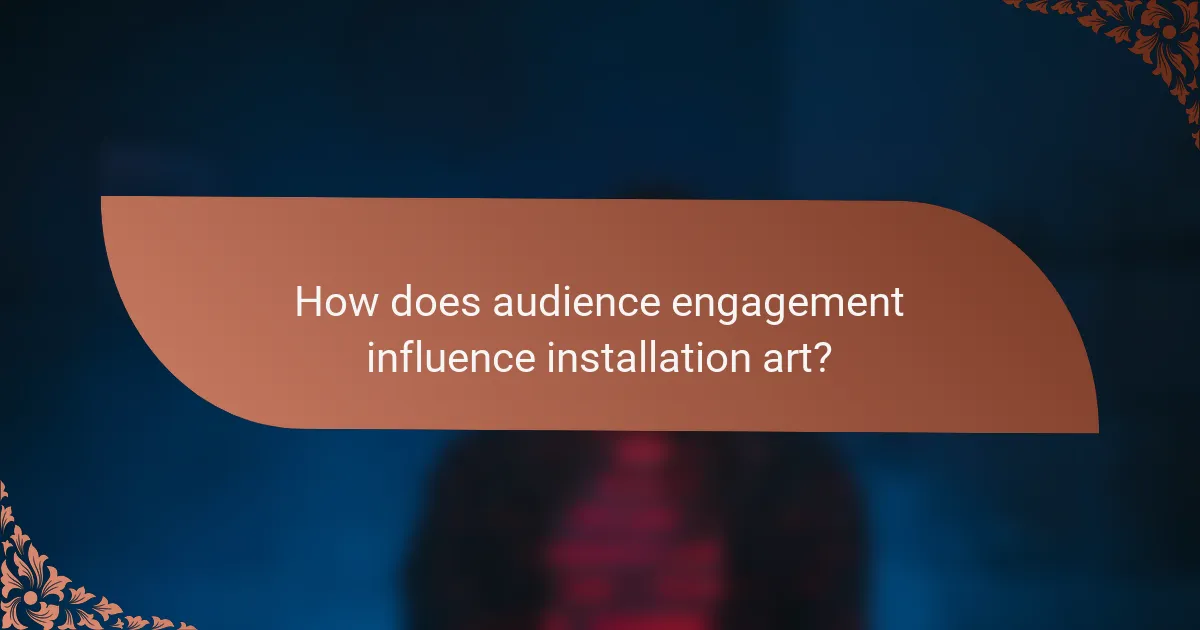
How does audience engagement influence installation art?
Audience engagement significantly enhances installation art by fostering interaction and emotional connection. Engaged viewers contribute to the artwork’s meaning and experience, often altering their perception based on personal interpretations. This dynamic relationship allows artists to create immersive environments that respond to audience feedback, encouraging participation and dialogue. Notable exhibitions have demonstrated that when audiences actively engage, the art transcends traditional boundaries, becoming a shared experience that evolves over time.
What interactive elements are often included in installation art?
Installation art often includes interactive elements like audience participation, sensory experiences, and digital technology. These components enhance engagement and create immersive environments. For example, some installations invite viewers to manipulate objects or interact with projections, fostering a dynamic relationship between the art and the audience. Unique attributes of installation art often include site-specific designs and the integration of various media, which can result in rare experiences that vary from one exhibition to another.
How do different demographics respond to installation art?
Different demographics respond to installation art based on cultural background, age, and personal experiences. Younger audiences often embrace interactive elements, while older viewers may appreciate traditional narratives. Cultural context influences interpretation, with diverse backgrounds yielding varied emotional responses. Additionally, socioeconomic factors can affect accessibility and engagement with installation art.
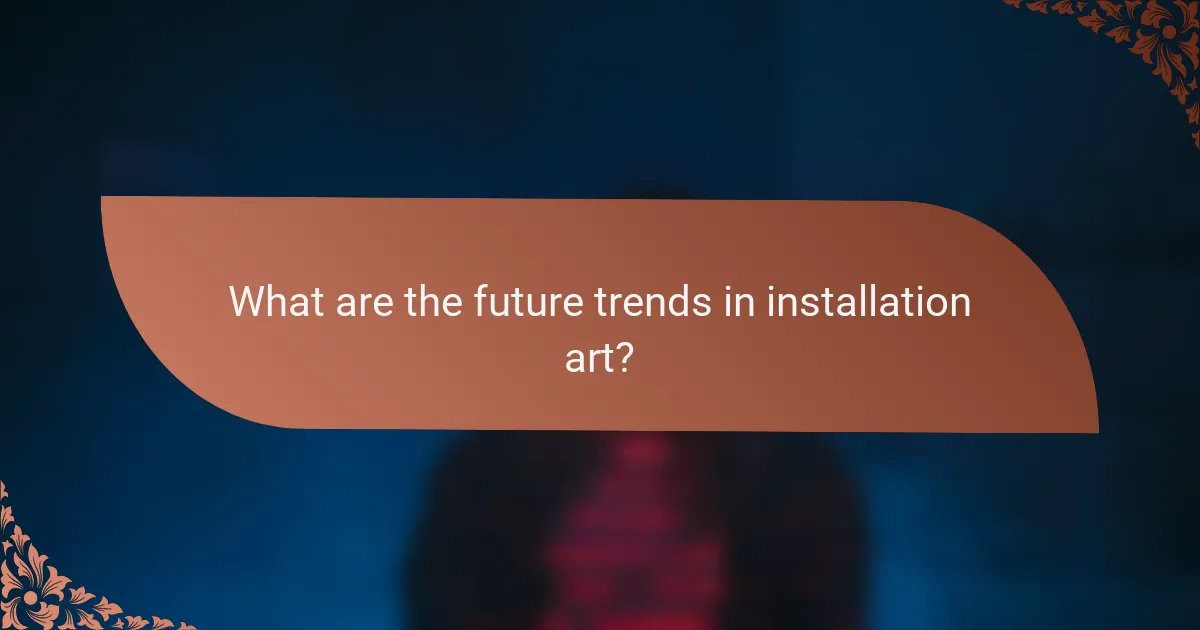
What are the future trends in installation art?
Future trends in installation art include increased use of technology, immersive experiences, and environmental themes. Artists are integrating virtual reality and augmented reality to create interactive installations. Sustainability is becoming a focal point, with works addressing climate change and ecological issues. Collaborative projects are also rising, engaging communities in the creation process. Lastly, installation art is expanding beyond galleries into public spaces, making art more accessible.
How might sustainability impact installation art practices?
Sustainability significantly influences installation art practices by promoting eco-friendly materials and concepts. Artists increasingly prioritize environmental awareness, integrating sustainable practices into their work. This shift encourages innovative approaches, such as using reclaimed materials and minimizing waste. Notable exhibitions now emphasize sustainability as a core theme, engaging audiences in dialogues about ecological responsibility.
What emerging artists are redefining installation art today?
Emerging artists redefining installation art today include artists like Yayoi Kusama and Olafur Eliasson. Their innovative approaches challenge traditional boundaries and engage audiences in new ways. Kusama’s immersive environments, characterized by polka dots and infinity rooms, create a sense of endlessness. Eliasson’s installations often incorporate natural elements, inviting viewers to interact with their surroundings. Other notable figures include Anish Kapoor, known for his monumental sculptures, and Tavares Strachan, who explores themes of identity and history through immersive experiences. These artists exemplify how installation art evolves by merging technology, environment, and personal narratives.
What best practices should artists consider when creating installation art?
Artists should prioritize audience engagement, site-specific concepts, and material choices when creating installation art. These best practices enhance the overall impact and experience of the artwork.
First, consider audience interaction. Installation art thrives on viewer participation, so design elements that invite exploration and emotional responses. Second, focus on the site. Tailor the installation to the environment, incorporating local culture, history, or architecture to create a meaningful connection. Lastly, choose materials wisely. Select sustainable or innovative materials that enhance the artwork’s message and durability.
By integrating these practices, artists can create compelling installations that resonate with viewers and foster deeper connections.
